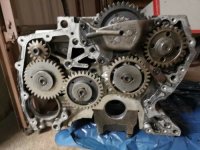pjm-84
Super Poster
VIP Member
- Messages
- 2,668
- Vehicle
- T5 SE 180
A friend had his belt changed but not the tensioner. This failed and caused about £1200 worth of damage.
It would be interesting to find out if VW are offering differing advice depending on the intended market for the vehicle.
It would be interesting to find out if VW are offering differing advice depending on the intended market for the vehicle.














